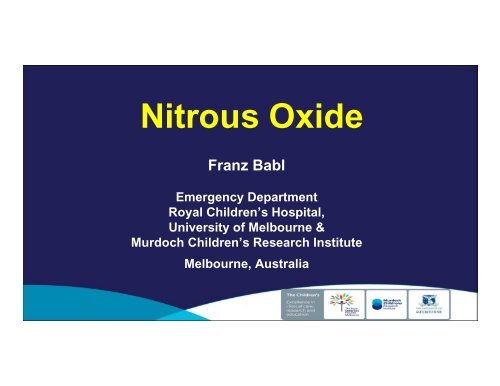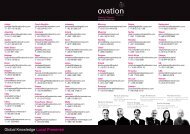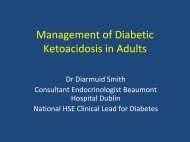Nitrous Oxide - MCI
Nitrous Oxide - MCI
Nitrous Oxide - MCI
You also want an ePaper? Increase the reach of your titles
YUMPU automatically turns print PDFs into web optimized ePapers that Google loves.
<strong>Nitrous</strong> <strong>Oxide</strong><br />
Franz Babl<br />
Emergency Department<br />
Royal Children’s Hospital,<br />
University of Melbourne &<br />
Murdoch Children’s Research Institute<br />
Melbourne, Australia
The History of <strong>Nitrous</strong> <strong>Oxide</strong><br />
• First synthesized Joseph Priestley in 1772<br />
• Psychotropic effects in 1799 –recreational use<br />
• Advertisement in 1844 “Those who inhale the gas once, are<br />
always anxious to inhale the second time….No language can<br />
describe the delightful sensation produced” seen by dentist<br />
Horace Wells –used as dental analgesia<br />
• In use as anaesthetic since (160 years!)…while others have<br />
disappeared (ether, chloroform etc)
<strong>Nitrous</strong> <strong>Oxide</strong><br />
• Colourless, odorless gas<br />
• Non‐flammable but does support combustion<br />
• Produced by heating ammonium nitrate at 240°C<br />
– Impurities including nitrogen, ammonia etc removed<br />
• Stored in blue cylinders<br />
• Simultaneous liquid and vapour phase<br />
– Pressure constant in cylinder until all liquid N 2O is vaporised<br />
• Most institutions piped to operating suites
How Does <strong>Nitrous</strong> <strong>Oxide</strong> Work?<br />
• Anaesthetic<br />
– Inhibition of excitatory glutamatergic<br />
neuro‐transmission<br />
(different from GABA receptors for<br />
many parenteral and inhaled agents)<br />
• Analgesic<br />
– Complex: corticotropin release<br />
hypothalamus<br />
Sanders Anesthesiology 2008
<strong>Nitrous</strong> <strong>Oxide</strong> as an Anaesthetic Agent<br />
• Most widely used anaesthetic gas worldwide<br />
…but slowly declining in some countries<br />
• Rapid onset and offset<br />
• But low anaesthetic potency<br />
– MAC minimum alveolar concentration 104%<br />
• MAC lung concentration of agent to prevent movement<br />
– Not sole anaesthetic agent<br />
– Need for oxygen
<strong>Nitrous</strong> <strong>Oxide</strong> in Anaesthesia<br />
Furious battle in the world of anaesthesia<br />
Myles, Leslie
<strong>Nitrous</strong> <strong>Oxide</strong> in Anaesthesia
<strong>Nitrous</strong> <strong>Oxide</strong> in Anaesthesia
<strong>Nitrous</strong> <strong>Oxide</strong> Effect on B12<br />
Ml L li A h& I i C 2004
<strong>Nitrous</strong> <strong>Oxide</strong> Effect on B12
<strong>Nitrous</strong> <strong>Oxide</strong> on B12
• N 2 O + O 2 (70/30) vs O 2 + nitrogen (80/20)<br />
– 2050 patients, for at least 2 hours, mean age 55 y.o<br />
• Lower rate of major complications without N 2 O<br />
– Fever, wound infection, pneumonia, atelectasis, N&V<br />
• Lower cost Graham Anesthesiology 2011<br />
• No change stroke or death but ↑MI Leslie Anesth Analg 2011<br />
• Design issues: ? outcome 2° protective effect of ↑O 2
What Does This Mean for <strong>Nitrous</strong> <strong>Oxide</strong> Use in<br />
Procedural Sedation and Analgesia in Children?<br />
Main issues:<br />
• Expansion of air space<br />
• Abnormal homocysteine metabolism<br />
• B12 or folate deficiency<br />
• Occupational exposure<br />
• Diffusion hypoxia
Problems with <strong>Nitrous</strong> <strong>Oxide</strong><br />
Expansion of Air Spaces<br />
• N2O solubility 34x nitrogen<br />
• Diffuses rapidly into closed air space<br />
• If compliant<br />
– Volume expansion<br />
• Air embolus, pneumothorax, distended bowel<br />
• Can occur rapidly x2 size in 10 minutes<br />
• Non compliant<br />
– Pressure<br />
• Sinuses, middle ear, intracranial, viteoretinal surgery – blindness<br />
secondary to retinal artery occlusion
Problems with <strong>Nitrous</strong> <strong>Oxide</strong><br />
Homocysteine & B 12 Metabolism<br />
• N2O irreversibly oxidizes cobalt atom of B12 →<br />
inactivates B12 dependent enzymes<br />
• Initially bone marrow and neurological problems with N2O for several days<br />
or recreational users<br />
• N2O > 2h increases homocysteine levels in children<br />
Pichardo Anesthesiology 2012<br />
• Metabolic diseases of methionine metabolism<br />
– Homocysteinuria, methylmalonic acidaemia, methionine synthetase deficiency<br />
– Single cases of death or myelopathy / macrocytic anaemia after N2O Baum Ped Anesth 2007
Problems with <strong>Nitrous</strong> <strong>Oxide</strong><br />
Homocysteine & B 12 Metabolism<br />
• B 12 effect<br />
– Neurological (neuropathy) and haematologic disease (bone marrow<br />
failure) after N2O in patients with low B12 – Case reports, “prolonged” exposure<br />
– Pernicious anaemia<br />
– Resected terminal ileum<br />
– Dietary deficiency /vegan<br />
Baum Ped Anesth 2007<br />
Sanders Anesthesiology 2008
Problems with <strong>Nitrous</strong> <strong>Oxide</strong><br />
Occupational Exposure<br />
• Occupational exposure limits (OELs, 8h time‐weighted average) variable 25‐<br />
100 ppm<br />
– Pre‐scavenging often exceeded<br />
• May have effect via inhibition methionine synthetase<br />
• No conclusive evidence for<br />
– Reproductive, genetic, haematologic or genetic effect<br />
– Many problems in occupational studies<br />
• Inconclusive results & many design problems<br />
• Very high doses vs not scavenged vs scavenged<br />
• Confounding agents, anaesthetics Sanders Anesthesiology 2008
Problems with <strong>Nitrous</strong> <strong>Oxide</strong><br />
Green House Gas<br />
• Most N2O agriculture, fossil fuels, microbes in soil<br />
• N2O increasing in atmosphere<br />
• 300 x more global warming potential than CO2 • Ozone depleting<br />
• Lasts for 120 years<br />
• In US anaesthesia 3%<br />
of N2O emissions<br />
Ishizawa Anes & Anal 2011
Problems with <strong>Nitrous</strong> <strong>Oxide</strong><br />
Other<br />
• Diffusion hypoxia at end of procedure<br />
– O2 after completion of procedure<br />
• Changes cerebral blood flow, ↑ICP<br />
– Caution after head injuries
Contraindications for<br />
<strong>Nitrous</strong> <strong>Oxide</strong> in Anaesthesia<br />
Sanders Anesthesiology 2008
<strong>Nitrous</strong> <strong>Oxide</strong> for PSA
<strong>Nitrous</strong> <strong>Oxide</strong> for PSA<br />
• Available as premixed gas (cylinder) 50% O2 and 50% N2O (e.g.<br />
Entonox) vs<br />
• Variable concentration mixing device (e.g. Quantiflex<br />
machine) with monitored dial mixer 0% to 70% N2O<br />
• Continuous flow ‐any age vs<br />
• Demand valve‐ requires negative pressure to open valve‐ >4<br />
year olds
Display N 2 O<br />
flow<br />
Flow control<br />
dial<br />
O 2 flush<br />
Reservoir<br />
bag<br />
Dial up O 2<br />
mixture<br />
Display O 2<br />
flow<br />
Scavenging
<strong>Nitrous</strong> <strong>Oxide</strong> for PSA<br />
Set‐up<br />
• Room ventilation occupational health and safety<br />
rated for nitrous use<br />
• Scavenging system in place<br />
• Bacterial filter between mask/mouth piece and<br />
circuit<br />
• Suction and resuscitation equipment operative
<strong>Nitrous</strong> <strong>Oxide</strong> for PSA<br />
Problems to Anticipate<br />
• If not piped, sufficient supply<br />
• Correct attachment of inspiratory/expiratory hoses<br />
– Colour coding<br />
• Scavenging system attached and turned on<br />
– Attached to wall suction<br />
• Bacterial filter attached<br />
• Scented essences (e.g. chocolate) to mask, not filter
<strong>Nitrous</strong> <strong>Oxide</strong> for PSA<br />
Preparing Patient and Venue
<strong>Nitrous</strong> <strong>Oxide</strong> for PSA
<strong>Nitrous</strong> <strong>Oxide</strong> for PSA<br />
Administration<br />
• Face mask with adequate seal<br />
• Adjust the gas supply for adequate flow by monitoring<br />
reservoir bag<br />
• Dial up N2O 50% to 70%<br />
• 3‐5 min N2O prior to start procedure<br />
• Monitor sedation level and adjust N2O • Continuous O2 saturation monitoring<br />
• After completion procedure 2 min 100% O2 to avoid diffusion<br />
hypoxia
• Efficacy<br />
• Safety<br />
• High concentration<br />
• Age cut offs<br />
• Fasting<br />
• Administration<br />
• Combination agents<br />
<strong>Nitrous</strong> <strong>Oxide</strong> for PSA<br />
Questions
<strong>Nitrous</strong> <strong>Oxide</strong> for PSA<br />
Efficacy<br />
• Several studies, including placebo controlled single agent<br />
RCTs, have shown sedative and analgesic efficacy in children<br />
• Discharge readiness<br />
– RCT ketamine + midazolam vs N 2 O + haematoma block<br />
Luhmann<br />
Pediatrics<br />
2006
<strong>Nitrous</strong> <strong>Oxide</strong> for PSA<br />
Safety<br />
• Several large series with very low rate serious<br />
adverse events<br />
Zier Ped Emerg Care 2011
Babl Pediatrics 2008<br />
<strong>Nitrous</strong> <strong>Oxide</strong><br />
High Concentration<br />
Zier Ped Emerg Care 2011
<strong>Nitrous</strong> <strong>Oxide</strong><br />
High Concentration<br />
• Significant adverse events at 50 % vs 70%<br />
– No difference Babl Pediatrics 2008<br />
• Sedation depth at 50% vs 70%<br />
Zier Ped Emerg Care 2011<br />
– Sedation depth lower (p=0.002) but not clinically significant<br />
(0.5 score at limit of CI)<br />
• No data as to higher efficacy<br />
Babl Pediatrics 2008
• Is it safe < 3 years of age?<br />
<strong>Nitrous</strong> <strong>Oxide</strong><br />
High Concentration<br />
– No sig. difference in adverse events (vs older)<br />
– No sig difference in sedation depth (vs older)<br />
(190
<strong>Nitrous</strong> <strong>Oxide</strong> for PSA<br />
Fasting<br />
• No reported aspiration in PSA with N2O alone<br />
• Fasting vs vomiting (n= 220)<br />
– Fasting 6 hours<br />
6% (95% CI 2‐15%) > 6 hours<br />
7% (95% CI 4%‐12%)
• Face mask<br />
<strong>Nitrous</strong> <strong>Oxide</strong> for PSA<br />
Administration Technique<br />
• Mouth piece<br />
• Nasal mask<br />
Zier Ped Emerg Care 2011<br />
• “Machine” e.g.<br />
Pedisedate<br />
Brown Ped Anaesth 2009<br />
• Advantages of mask: young age, exposed mouth/nose, loss of<br />
cooperation at critical time point; targeted distraction
<strong>Nitrous</strong> <strong>Oxide</strong><br />
Satisfaction & Recall<br />
• Staff 90% satisfied with analgesia and sedation<br />
• “Inadequate sedation” 2%<br />
• Parents<br />
• 96% satisfied or very satisfied procedure<br />
• 92% satisfied or very satisfied with sedation<br />
• 93% happy to use again<br />
Babl EMJ 2007<br />
• Children<br />
• 26% no recall of procedure Babl EMJ 2007<br />
• 47% of fracture reductions no recall Hopper unpublished<br />
• 65% no recall Kanagasundaram Arch Dis Child 2001
<strong>Nitrous</strong> <strong>Oxide</strong>
<strong>Nitrous</strong> <strong>Oxide</strong><br />
Lack of Analgesic Potency<br />
• Combine with topical/local/regional/intravenous anaesthesia<br />
• Haematoma block Luhmann Pediatrics 2006<br />
• Combine with opioid<br />
analgesia
<strong>Nitrous</strong> <strong>Oxide</strong><br />
Lack of Analgesic Potency<br />
• Pilot study (n=41) N 2O with IN fentanyl (1.5 mcg/kg)<br />
– IN fentanyl 14 min (mean) prior to N2O – Mostly x1 dose; 80% orthopaedic procedures<br />
• No serious adverse events<br />
• Vomiting rate higher vs N20 alone<br />
– 20% (95% CI 7% ‐ 31%) vs 6% (95% CI 4% ‐ 7%) p
<strong>Nitrous</strong> <strong>Oxide</strong><br />
• Useful agent for PSA in children<br />
• Few limitations<br />
• Single agent nitrous oxide safe<br />
• High dose (70%) safe<br />
• Analgesic potency limited<br />
• Combination with opioids likely trade off analgesia vs<br />
adverse events







